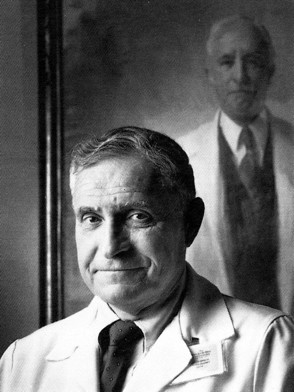To Understand Obesity, First Invent the Tools: The Metabolic Function of Fat

Hirsch, Jules
In the late 1950s, when Jules Hirsch (1927- ) became interested in studying obesity, most scientists considered fat, or adipose tissue, to be inert—a passive insulator in which the body stores energy in the form of triglycerides. Over the next decade, in the first studies on human fat metabolism, Hirsch gained fundamental insights into the normal function of fat in the human body and how this differs in the obese. This groundbreaking research depended on long-term observations of patients in the Rockefeller Hospital, the proximity of state-of-the-art chemistry laboratories, and the ability to carry on research between these two arenas.
Hirsch had worked for several years with Edward H. Ahrens, Jr. (1915-2000) at Rockefeller, perfecting techniques for separating fats, or lipids, from other compounds and from each other. It was the heyday of technology for chemical separation—in other Rockefeller laboratories a method called countercurrent distribution was being developed, and chemists were inventing tools to analyze amino acids. Hirsch first developed a method of silicic acid chromatography for separating complex lipid mixtures. He also experimented with columns using factice, and demonstrated the use of differential refractometry for precisely monitoring column eluates—a method later incorporated into high performance liquid chromatography.
These powerful tools helped launch Hirsch on investigations into obesity that he has pursued for decades. Little research had been done on human adipose tissue because the large samples needed were difficult to obtain. But the new separation techniques made it possible to analyze lipids in very small samples, and Hirsh devised a simple way to obtain these from human subjects by drawing the tissue out in a syringe. In studies at the Rockefeller Hospital, Hirsch fed patients precisely defined formula diets and discovered that the composition of fat in adipose tissue mirrored the fat in the diet for both obese and lean individuals. In addition, the tissue was metabolically active, taking up glucose and fat, and releasing fat at rates readily changed by hormones such as insulin and epinephrine.
During these first studies of obese individuals, Hirsch also discovered that restricted calorie diets had effects beyond weight loss—his patients showed physiological signs of semi-starvation, such as slower heart rates, feeling cold, and lowered white blood cell counts. They also became depressed and preoccupied with food, and they developed a distorted body image, seeing themselves in the mirror as heavier than they actually were. Hirsch's behavioral observations of human subjects provided further evidence that adipose tissue had an important regulatory function in the body, and they pointed the way to a new phase of research, the study of fat cells.
Jules Hirsch received his undergraduate education at Rutgers University and earned the MD at Southwestern Medical School, University of Texas - Dallas (1948). After an internship at Duke University Hospital and residencies at Upstate Medical Center in Syracuse, NY, he joined the Rockefeller Institute in 1954. Hirsch served as Physician-in-Chief of the Rockefeller University Hospital from 1992 to 1996, and chairman of the institutional review board from 1984 to 1996. He has been president of the Association for Patient-Oriented Research and the American Society for Clinical Nutrition, and contributed as an editor or editorial board member to more than a dozen journals. Among many honors and awards, Hirsch has been elected to the Institute of Medicine, and he received the Stunkard Lifetime Achievement Award from The Obesity Society in 2006.
Selected Publications
Hirsch J and
Ahrens EH Jr. The separation of complex lipide mixtures by the use of
silicic acid chromatography. J Biol Chem, 1958, 233: 311-320
http://www.jbc.org/cgi/reprint/233/2/311
Hirsch J. Factice chromatography: An automatically monitored liquid-gel
system for the separation of non-polar lipids. J Lipid Res, 1963, 4:
1-10
http://www.jlr.org/cgi/reprint/4/1/1
Hirsch J, Farquhar JW, Ahrens EH Jr, Peterson ML, and Stoffel W. Studies of adipose tissue in man, a microtechnic for sampling and analysis. Am J Clin Nutr, 1960, 8: 499-511
Hirsch J and Goldrick RB. Serial studies on the metabolism
of human adipose tissue. I. Lipogenesis and free fatty acid uptake and
release in small aspirated samples of subcutaneous fat. J Clin Invest,
1964, 43: 1776-1792
http://www.jci.org/articles/view/105052/pdf
Goldrick RB and Hirsch J. Serial studies on the metabolism of human
adipose tissue. II. Effects of caloric restriction and refeeding on
lipogenesis, and the uptake and release of free fatty acids in obese
and nonobese individuals. J Clin Invest, 1964, 43: 1793-1804
http://www.jci.org/articles/view/105053/pdf
Glucksman ML and Hirsch J. The response of obese patients to weight
reduction: I. A clinical evaluation of behavior. Psychosom Med, 1968,
30: 1-11
http://www.psychosomaticmedicine.org/cgi/reprint/30/1/1
Glucksman ML, Hirsch J, McCully RS, Barron BA, and Knittle JL. The
response of obese patients to weight reduction: II. A quantitative
evaluation of behavior. Psychosom Med, 1968, 30: 359-373
http://www.psychosomaticmedicine.org/cgi/reprint/30/4/359
Glucksman ML and Hirsch J. The response of obese patients to weight
reduction: III. The perception of body size. Psychosom Med, 1969, 31:1-7
http://www.psychosomaticmedicine.org/cgi/reprint/31/1/1
Further Reading
Hirsch J. Obesity: Matter over mind? Cerebrum, 2003, 5: 7-18
http://www.dana.org/news/cerebrum/detail.aspx?id=2908
